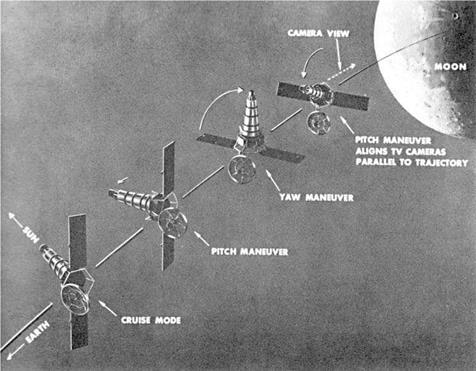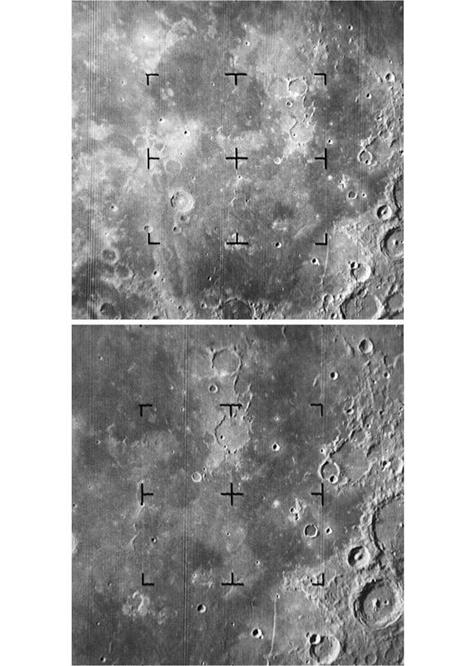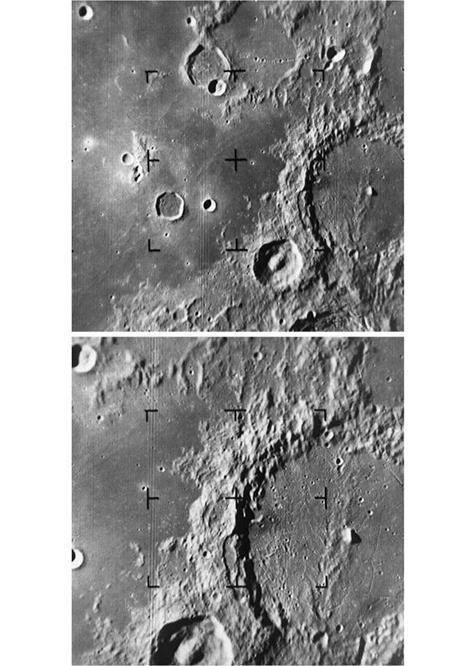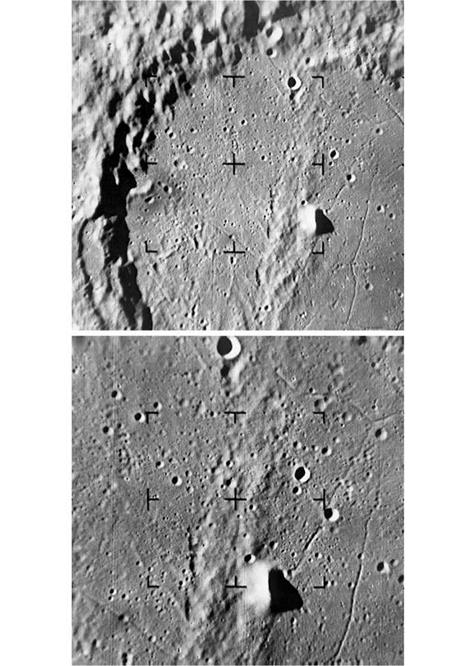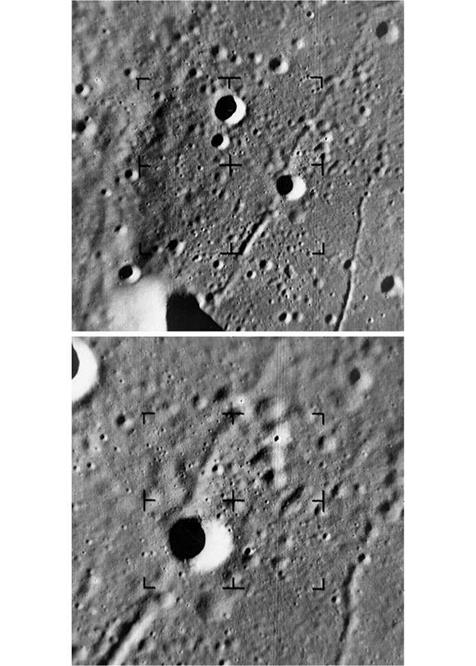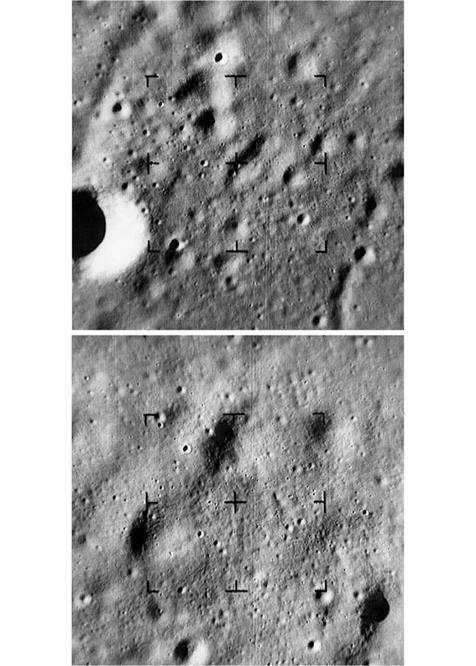TV SPECTACULAR
On 27 February 1965 the Ranger experimenters met at JPL with representatives of the Surveyor and Apollo projects to consider the target for the final Block III with a window that would open on 19 March. The Moon would be ‘full’ on 17 March and ‘last quarter’ on 25 March. The Surveyor people argued for Oceanus Procellarum at the western end of the Apollo zone, to identify a safe target for their first soft-lander, but this was rejected. Accepting that the maria were probably all much the same, the Apollo people suggested inspecting a blanket of ejecta, to gain an impression of the roughness of such terrain. The Ranger experimenters themselves argued for a target of particular scientific interest, and this was accepted.
The Ranger team met again on 2 March to consider specific features. To obtain unique data, they considered a variety of locations that were unlikely to be visited by either Surveyor or Apollo – three being Copernicus, Kepler, and Schroter’s Valley near Aristarchus. However, Harold Urey and Gerard Kuiper were both in favour of the crater Alphonsus. Its floor was generally flat, but contained irregular rilles and a number of small ‘dark-halo’ craters which some people thought might be of volcanic origin. Following reports by Dinsmore Alter in America in 1956 of a slight ‘‘veiling’’ of the floor of Alphonsus, Nikolai Kozyrev had monitored the crater for any further such ‘transient events’, and on 3 November 1958 obtained a spectrogram of a ‘‘glow’’ obscuring the 1,100-metre-tall central peak using the 48- inch reflector of the Crimean Observatory. The spectrogram was disputed, but Kozyrev interpreted it as a release of gas. Alphonsus was therefore selected as the primary target for Ranger 9.
The experimenters could not agree a target east of the meridian for early in the window, but a launch on 21 March was compatible with Alphonsus, and thereafter Copernicus, Kepler and Aristarchus on successive days. This list was sent to the Office of Space Sciences and Applications on 10 March. Oran Nicks endorsed it, and passed it to Homer Newell, who concurred. However, NASA had scheduled the Gemini 3 manned mission for 22 March, and the Air Force required a clear 24 hours to reconfigure the Eastern Test Range for a different type of launch vehicle. On 15 March Robert Seamans ordered Gemini 3 postponed to 23 March to give Ranger 9 a chance at its primary target. When the countdown began, the Cape was cloudy and the low-altitude winds were gusty. The clock was held to await an improvement in conditions. Although it remained cloudy, when the winds declined it was decided to proceed.
Soon after lifting off at 21:37 GMT on 21 March (just before that day’s window closed) the vehicle penetrated the cloud deck and was lost from sight. But everything went to plan. The midcourse manoeuvre was deferred to enable radio tracking by the Deep Space Network to precisely define the initial trajectory. It was calculated that
|
As Ranger 9 approached the Moon it performed a terminal manoeuvre to point its cameras along the velocity vector. |
the spacecraft would impact some 640 km north of Alphonsus. The 31-second burn at 12:30 on 23 March ensured that it would fall into the 112-km-diameter crater. The aim point was midway between the central peak, the rilles and the dark-halo craters so that they would all be visible during the approach at a resolution better than was possible telescopically; but they would not appear in the final images, which would give a view of the floor of the crater.
As Ranger 9 approached the Moon on 24 March it became the first spacecraft in the project to make a terminal manoeuvre. At 13:31 the vehicle departed its cruise attitude by pitching, yawing, and pitching again whilst holding its high-gain antenna pointing at Earth. By aiming the cameras along the velocity vector, this manoeuvre would optimise the resolution of the final frames. Ray Heacock, the JPL member of the experiment team, provided the commentary in the auditorium. The electronic scan converter made for the Surveyor project had been hastily modified to process the Ranger video for ‘live’ broadcast by the TV networks. In essence, this comprised two sets of vidicon tubes (one for the wide-angle stream and the other one for the narrow-angle stream) and in each case one vidicon viewed the image displayed on its counterpart, in the process converting the 1,132 lines per frame received from the spacecraft into the 500 lines of the commercial
|
|
|
|
|
|
|
|
|
|
Ranger triumphs
![]()
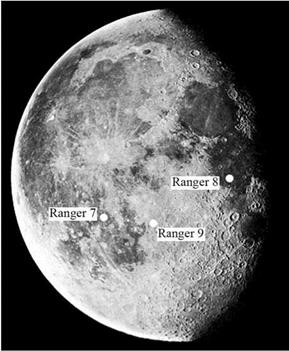 The sites inspected by the successful Ranger missions.
The sites inspected by the successful Ranger missions.
system.[24] Imaging began at an altitude of 2,400 km, lasted 18 minutes, and ended with impact at 14:08:20 when the spacecraft hit the ground at 9,617 km/hour within 6 km of the aim point.[25] The final picture of the 5,814-frame sequence had a resolution of 25 cm. It was a spectacular way to conclude the Ranger project! The transmission impressed not only the public, but also those scientists who had not appreciated the value of imagery.
At the experimenters’ press conference later in the day, Gerard Kuiper said the ‘dark halo’ craters on the floor of Alphonsus appeared to be volcanic. Harold Urey, no fan of the ‘hot’ Moon hypothesis, allowed that they were probably ‘‘due to some sort of plutonic activity’’. The rilles were revealed not to be clefts but chains of small irregular craters, which some people argued were volcanic. The walls of Alphonsus were very smooth. The central peak was not the harsh edifice depicted by artists. There was no indication that it was a volcano, but neither was there evidence that it was not. There was no clue as to the cause of the ‘transient events’ seen by Alter or Kozyrev.
Mission accomplished 135











